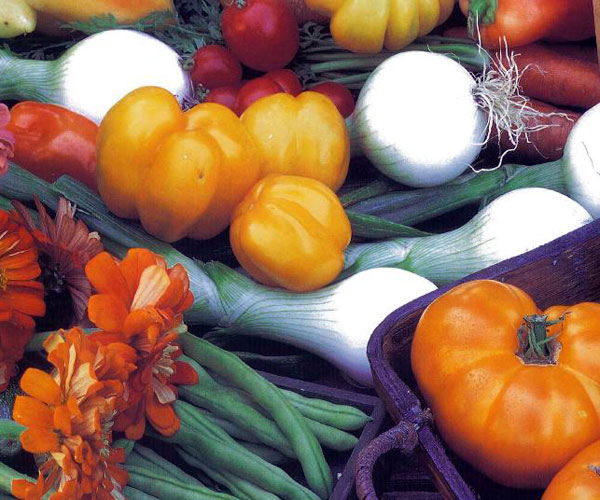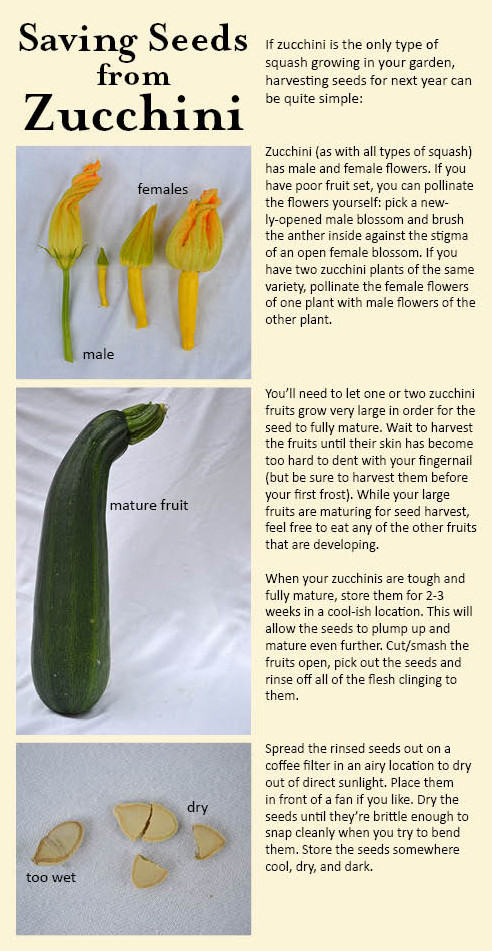Online Seed Exchange
/Seed Savers Exchange (SSE) is proud to provide a new tool to help seed savers and gardeners keep the diversity of our garden heritage in the hands of many: an online seed exchange.
Read MoreSeed Savers Exchange (SSE) is proud to provide a new tool to help seed savers and gardeners keep the diversity of our garden heritage in the hands of many: an online seed exchange.
Read MoreAlthough seed maturity can often be evaluated by simply touching or viewing the fruit or vegetable, SSE’s Farm Manager Bryan Stuart has a more unique approach for some seeds - he chews on them.
Read MoreWhen you have an orchard like Seed Savers with 550 apple varieties, no two pies are the same (or at least they shouldn’t be—what’s the fun in that?). Orchard Manager Dan Bussey reveals his favorite pie recipe with tips and tricks for working with heirloom apple varieties.
Read More
 When I grab a basket and go to my garden to gather fresh vegetables and herbs, it's like going to my own little market. I look at gardening as a good workout and a chance to listen to the sounds of nature.
When I grab a basket and go to my garden to gather fresh vegetables and herbs, it's like going to my own little market. I look at gardening as a good workout and a chance to listen to the sounds of nature.
My favorite summertime recipes are those that require one trip to the garden to gather most of the ingredients, such as the following.
This recipe, as seen in the 2009 Seed Savers Exchange calendar, was a prize winner in the 2002 Food for Thought Recipe Contest in Madison, Wisconsin and printed in From Asparagus to Zucchini, a cookbook sponsored by the Madison Area Community Supported Agriculture Coalition.
I used the 'Amish Paste' tomato in this recipe. The healthy vines are producing blemish-free, flavorful red fruit that is excellent for fresh eating as well as preserving. Our growing season started out very wet and cool, and despite the dry weather since then, these plants continue to produce beautiful, tasty fruit.
The green beans I used were 'Ideal Market' and 'Purple Podded Pole' which are both very productive varieties. The Ideal Market produces colorful blossoms, and of course the Purple Podded Pole plant is decorative in all stages.
2 tablespoons extra-virgin olive oil 1 clove garlic, minced ¼ teaspoon red pepper flakes ½ cup sliced onions 2 teaspoons dried ground thyme ¼ cup water 1 pound green beans, ends clipped, cut in half 1 sprig rosemary, leaves torn off the stem 2 medium tomatoes cut into wedges Salt and pepper to taste
Heat olive oil over medium heat. Add garlic and red pepper flakes and sauté until fragrant. Add onions, sauté until translucent, 3-5 minutes. Add water, thyme, and green beans. Stir. Cover, and steam-cook beans until nearly done, 10-15 minutes. Stir in rosemary and tomatoes. Cook briefly, until tomatoes are warmed through. Season as necessary. Serves 4.
Seed Savers Exchange is a non-profit organization dedicated to conserving and promoting America’s culturally diverse but endangered garden and food crop heritage for future generations by collecting, growing, and sharing heirloom seeds and plants.
Did you know that nylon stockings make the ultimate, multipurpose tool? They keep legs warm and physical imperfections under wraps; they are maggot barriers for emerging apples; and, in a pinch, they're nice material for that last minute bungee cord. But we at Seed Savers have been privy to a very unsung use for the common pantyhose: they make a darned safe way to mail your prized heirloom seeds.
Read More

Of course, here at Seed Savers Exchange we can't help but to encourage you to try your hand at saving seeds for next year's garden (scroll down to find a how-to guide for saving zucchini seeds). If you're interested in maintaining the characteristics of your variety in the next generation, you'll need to make sure your plants weren't cross-pollinating with other varieties. Of course, it can be fun to have a little backyard hybridization, too. Select one or two zucchinis to leave on the vine and save their seeds, then have fun with the rest! Make zucchini breads, cakes or soups that can be frozen and enjoyed later; Donate to a local food pantry or drop some zucchini on a neighbor's porch.
[gallery columns="2" link="none" ids="3736,3737"]
Courtesy of Joanne Thuente of Seed Savers Exchange, here is a casserole her family loves:
Brown and season ground beef; set aside. (Omit beef for vegetarian option). Sauté onion and sliced zucchini in the olive oil for 10 minutes; season with salt and pepper. Add the tomatoes; simmer for another 10 minutes.
In a large buttered casserole dish (2½ quart), layer the ingredients in the following order: half of the vegetable mixture, half of the uncooked rice, all of the ground beef, the remaining rice, and end with the remaining vegetable mix. Cover and bake at 350 degrees for 45 minutes. Remove from the oven, uncover, sprinkle the grated cheese over the top, and return to the oven, uncovered, for a few minutes, just until the cheese melts.
Serves 4-6.

Find more seed saving tips on our website.
Seed Savers Exchange is a non-profit organization dedicated to conserving and promoting America’s culturally diverse but endangered garden and food crop heritage for future generations by collecting, growing, and sharing heirloom seeds and plants.
The heat of summer causes many garden greens to bolt and flower right around June here in northeast Iowa, and though spring salads of lettuce, spinach, arugula, and mustard aren’t quite in season anymore, there are plenty of heat-tolerant (or heat-loving) leaves to enjoy this time of the year.
Read More
Whether blended in a soup, pickled in a mason jar or baked in an omelet, eating is the best way to utilize scapes, a farm and garden byproduct of garlic. Seed Savers Exchange is conducting its first ever evaluation of over 300 garlic varieties in its production garden this year, which means harvesting a lot of scapes for scanning, as well as to ensure the garlic bulbs are adequately plump and ready for replanting in October. Looking out across the half-acre field waving with crowns of silvery green, these several hundred varieties may appear identical to the untrained eye, but in fact differ considerably in size and shape. Many are uniform in their likeness (streaking brown leaves as some had matured early), still others display anthropomorphic qualities unique to their row: one variety like a sumo wrestler, squat and thick, while another resembles the stern form of a lawman. Taken together, the melded identities of Allium sativum are a chorus of opportunity for SSE to learn more about this species (and its flowering appendage) in the Allium genus.
[gallery columns="2" link="file" ids="3405,3404"]
Our trial field includes both hard and softneck garlics. For those of us new to garlic varieties, softneck garlic doesn’t produce scapes, and generally isn’t as hardy (hence the cognate of its opposite, the “hardneck”), but, it does store better and mature quicker. The bulb size of many hardneck varieties is improved by removing the scape—its flowering stalk which eventually produces bulbils and flowers—hence getting “plump and ready for October." Some varieties, however, don't mind if you leave their scapes on until harvest time, such as those in the Turban group. It just goes to show – the more we learn about each variety’s characteristics, from planting to harvest, the more we’ll understand their preferences, personalities, and how best to make use of them.
Here’s a quick primer on Preservation’s Field & Lab Plant Evaluation
Any characteristic that has a genetic basis is recorded in evaluations at SSE, which, specific to garlic, includes observing and measuring:
1. leaf color 2. leaf posture 3. stalk height (or pseudostem) 4. scape shape (if applicable)
Everything is recorded into Preservation’s database—the hardneck scapes are harvested and scanned into a digital format—and staff can glory in the perk of free scapes for eating!
[gallery columns="2" link="file" ids="3406,3403"]
_______________________________________________________
 Visit the online store to purchase our certified organic seed garlic today. Over 10 varieties to choose from-- They will sell out!
Visit the online store to purchase our certified organic seed garlic today. Over 10 varieties to choose from-- They will sell out!
Then...
Check out this slide show and cheat sheet for planting your garlic.

Nora stated the following about her Italian Vegetable Ragout:
“This eggplant ragout draws its inspiration from ratatouille. Include tomatoes when they are ripe and in season. It’s good eaten hot, lukewarm, or cold. If you happen to have any of this flavorful ragout left, celebrate brunch by stirring some into scrambled eggs—or stuff it into pita pockets, add some feta cheese, and enjoy a memorable sandwich. Serve with steamed Romanesco broccoli or baked beans.”
Sauté the onion in the olive oil in a large sauté pan for 3 to 4 minutes or until soft. Add the garlic and eggplant, stirring to combine and coat with the oil. Season with salt to release the juices of the eggplant. Sauté until the eggplant becomes soft, about 5 minutes, stirring from time to time. Add the zucchini, stir and sauté for 2 to 3 minutes. Add the peppers, the mixed herbs, season to taste with pepper, and sauté for another minute or two. Remove the ragout from the heat while the peppers are still firm. Set aside and cool to room temperature. The heat of the pan will finish cooking the vegetables. Serves 4.
View all the heirloom eggplant in our catalog here.
The Seed Savers Exchange mission is to conserve and promote America’s culturally diverse but endangered food crop heritage for future generations by collecting, growing, and sharing heirloom seeds and plants.
Here at Seed Savers Exchange, to say we grow a wide variety of fruits, vegetables, and flowers would be an understatement. With decades of experience growing hundreds of vegetable varieties in production and garden settings, our crews at Seed Savers Exchange have learned a thing or two about support systems. Here are some trellises we like to use around the farm.
Read MoreSeed Savers Exchange is a nonprofit, member supported organization that collects, preserves and shares heirloom seeds for our future. Since 1975, SSE and our supporters have collected the seeds and stories that would otherwise have been lost.











Seed Savers Exchange is a tax-exempt 501(c)3 nonprofit organization dedicated to the preservation of heirloom seeds.
Seed Savers Exchange
3094 North Winn Road
Decorah, Iowa 52101
Send Us A Message
(563) 382-5990
Customer Service Hours:
Monday to Friday, 9am - 5pm CST
© 2020 Seed Savers Exchange